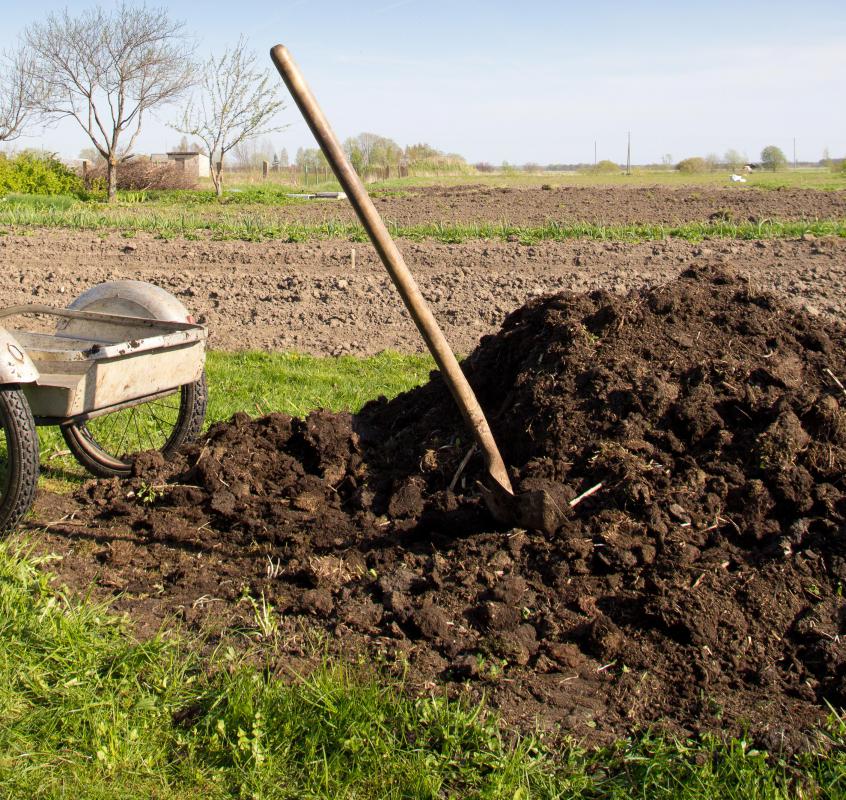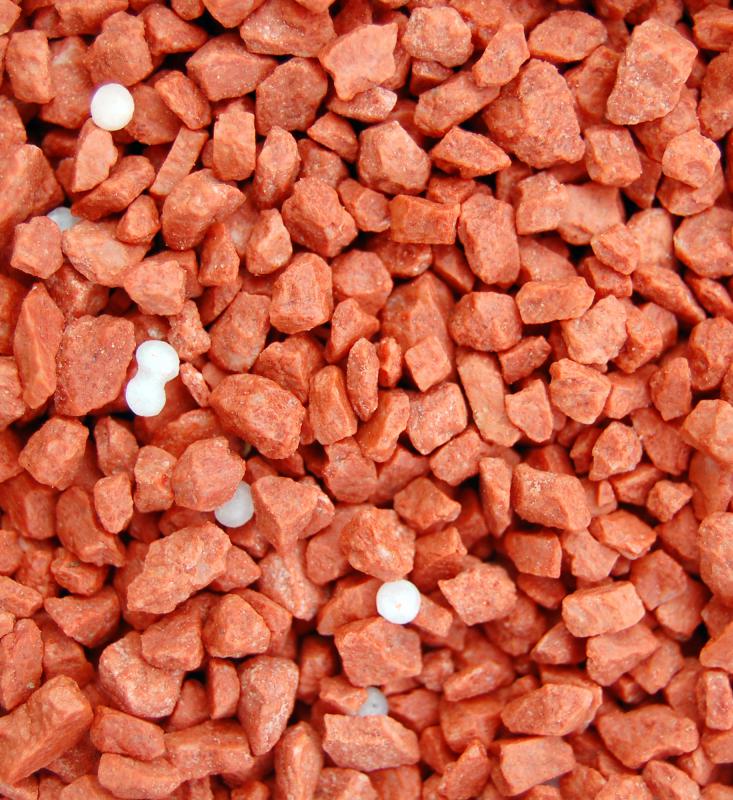At WiseGEEK, we're committed to delivering accurate, trustworthy information. Our expert-authored content is rigorously fact-checked and sourced from credible authorities. Discover how we uphold the highest standards in providing you with reliable knowledge.
How do I Choose the Correct Fertilizer?
Plants need a continuous supply of nutrients; however, sometimes the nutrients found naturally in the soil are not enough. In that case, fertilizer is needed. Choosing the correct type can be an overwhelming task. Most garden centers have shelves packed high with bags and containers of fertilizer — each type serving a specific purpose.
Nitrogen (N), phosphorus (P), and potassium (K) are the main nutrients that plants need to survive. Complete fertilizer contains those three ingredients and they are listed clearly as the N-P-K ratio. So, if a package states that its N-P-K ration is 10-6-6, then it contains 10% nitrogen, 6% phosphorus, and 6% potassium.

Nitrogen is generally the nutrient that plants and lawns need most. So, the first number or nitrogen should usually be the highest of the ratio. In addition, nitrogen is usually water-soluble or fast-release forms and/or in water-insoluble or slow-release forms. Water-soluble nitrogen satisfies the plants needs quickly, while insoluble nitrogen must be broken down by organisms in the soil before the plants can be fully satisfied.

Fertilizer can be either natural or chemical/factory-made. Natural varieties use compounds that would otherwise become waste, such as animal waste, dead organisms, and meals made from soybeans, blood, cottonseed, bone, alfalfa, and kelp. In most cases, natural fertilizer has lower nutrient levels than that which is factory-made, and is often more expensive than that created in a factory. To see the greatest improvement in plants and lawns, natural fertilizer should be applied in early spring or late fall.

Natural blood meal has an N-P-K ratio of 13-0-0. It is a good source of nitrogen and can be scratched into the soil around plants. Natural cottonseed meal has an N-P-K ratio of 6-2-1. It acidifies the soil when it fertilizes it and is usually used when soils are alkaline and the plants require more acidity, such as azaleas. Natural fish pellet fertilizer has an N-P-K ratio of 8-5-1 and is great for vegetable beds.

Factory-made or chemical fertilizer is usually mass-produced. It has higher levels of nutrients and has more soluble nitrogen than natural varieties. Lawns and plants can burn and become destroyed if too much of this type is used. Consequently, it is recommended that it is applied to moist soil and that the soil is irrigated again after it is applied, as well.
Both natural and chemical fertilizers can be purchased in liquid or solid forms. Liquid types supply nutrients to the roots immediately. They most commonly have an N-P-K ratio of 20-20-20. However, they need to be applied more frequently.

Solid fertilizer can be spread across a lawn or near plants and release nutrients slowly, over time. It does not wash away from rain or water systems as easily as liquid. There are several different N-P-K ratios available for solid fertilizers: 10-10-10 for all purpose use; 10-20-20 for vegetables; 6-10-4 for flowers; and 29-3-4 for lawns.
In general, fertilizers formulated for plants grown for their leaves and for lawns have higher nitrogen levels. Those formulated for flowering plants and fruits have higher phosphorus levels. There are also specialty varieties for vegetables, roses, fruits, and lawns. Understanding the N-P-K ratio and the kinds that are available should make choosing the correct type easier.
AS FEATURED ON:
AS FEATURED ON:















Discussion Comments
@cloudel – If you want to buy fertilizer for a specific type of plant, the best thing to do is look for fertilizers that state on the label that they are made for tomatoes. Sometimes, fertilizers will be made for multiple plants, but as long as tomatoes are listed as one of these, then it should be good for them.
I buy fertilizer that is made specifically for roses. Even though it can be used on other plants, roses are the first ones mentioned on the front label.
What is the best kind of tomato fertilizer? I just bought several tomato plants, and I don't want to use the wrong one and damage them.
@Perdido – I tried using bone meal in my flower bed, but it resulted in disaster. It attracted some kind of burrowing animals, and they dug the whole area up. They even ate some of my bulbs!
So, I started using a combination of pine needles and grass as fertilizer. I piled it up a few inches thick across my hyacinth and tulip bed in the fall and left it there over the winter.
Pine needles make the soil acidic, and I guess that the bulbs liked this, because they flourished the following spring. Since I have plenty of pine trees and grass, I may never have to buy fertilizer again!
Bone meal is a great organic fertilizer. It will give your plants calcium and phosphates, because it is actually made from ground up animal bones.
I use bone meal in my tulip bed. I dig a small trench across the area where the bulbs are planted, and I sprinkle the bone meal into it. Then, I spread the dirt back over the top of it and water the dirt so that the bone meal can soak into the ground.
It's great to use on many different bulbs. My tulips have performed very well with it.
well fertilizers are a tricky thing. a lot can't be transported overseas since the incident of the hole boat exploding. they discovered that chemicals where inside the fertilizer and it just went up in flames.
if your in america, try guano. it's the best. but remember to ask a professional what you should use to clean out the left-overs because you could get seriously injured.
Just received my soil analysis report from Texas A&M:
I am planning on laying Bermuda sod on a yard that does not contain much vegetation growth.
N was 4
P at 15
K at 103.
The critical level for Phosphorus (P) was 50ppm and Potassium (K) was 175ppm. For my soil and location the recommendations were as follows:
O.7 lbs. N/1000sqft,
2.1 lbs P205/1000sqft and
1.2 lbs K20/1000sqft.
I can make sense of the recommendations but, I am not completely sure as to what type of granular fertilizer (fast or slow release) and the N-P-K ratio to select. It may be that there is no complete fertilizer N-P-K ratio commercially available that fits the recommendations I received. Would I need to purchase each ingredient separately? Any advice would be greatly appreciated.
Post your comments